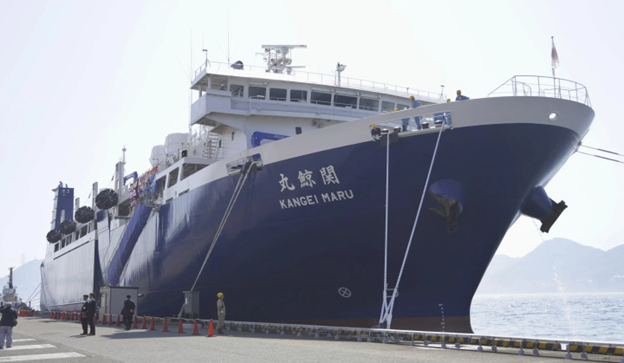Fin whale meat from off Japan’s northern coast was sold for the first time in nearly 50 years.
Japan’s Fisheries Agency this year added fin whales to its list of three whale species that can be legally hunted as the country expands commercial whaling along its coast.
Japan resumed commercial whaling within its exclusive economic zone after withdrawing from the International Whaling Commission in 2019. The IWC designated the fin whale as a species for protection from overhunting in 1976.
Japan said its recent stock surveys confirmed a sufficient recovery of fin whale populations in the North Pacific. Officials said 30 of the whales — half of the quota of 60 — were caught this season. Japan set a combined catch quota of 379 for the three other whale species — minke, Bryde’s and sei whales.
Photo: An auction selling fresh fin whale meat at a fish market in Shimonoseki, Yamaguchi prefecture, southern Japan, Thursday, December 12, 2024.
Approximately 1.4 tons of fresh meat caught off Hokkaido were available for purchase. The most expensive item at the market was the tail meat, which is considered a delicacy known as “onomi.”
It was sold 200,000 yen ($1,312) per kilogram (2.2 lbs), according to the city’s fishery promotion department.
“We hear the larger the whale, the better the taste, so I assume fin whales are more delicious than other kinds of whales, though I never had a chance to taste it and cannot compare,” city official Ryo Minezoe said.
Photo: The Kangei Maru, the world’s only whaling factory ship, in its home port in Shimonoseki, Yamaguchi Prefecture, western Japan.
The country’s only large-scale whaling fleet operator Kyodo Senpaku Co. launched the 7.5 billion-yen Kangei Maru — a 9,300-ton new ship — in 2024.
Last year, Japanese whalers caught 294 minke, Bryde’s and sei whales — less than 80% of the quota and fewer than the number once hunted in the Antarctic and the northwestern Pacific under the research program.
Other meats have largely replaced whale and supply has since fallen to around 2,000 tons in recent years, Fisheries Agency statistics show. Japanese officials want to increase that to about 5,000 tons, to keep the industry afloat.
Experts say they doubt there is much demand in Japan where whale meat is no longer a familiar, affordable food. The biggest question is if the industry can survive without government subsidies of hundreds of millions of yen.
Nobuhiro Kishigami, a professor and expert on indigenous whaling at National Museum of Ethnology in Osaka, said whale meat is eaten in some whaling towns but rarely in Tokyo or elsewhere in Japan. Whale meat is more expensive than beef or other meat. “This is supposed to be business, and without large government subsidies, I think it would be extremely difficult for it to be sustainable.”

